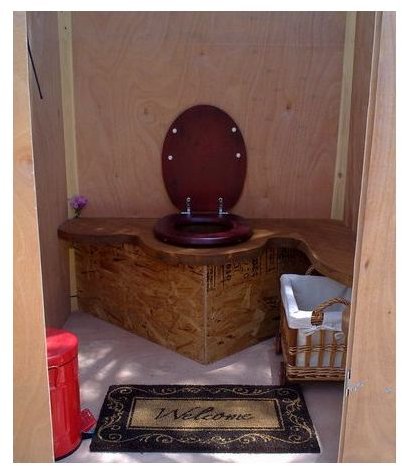How to Make a Compost Toilet Yourself Cheaply
How to Make a Compost Toilet
Small homemade compost toilets are made of a 5-gallon plastic bucket that is fitted with a toilet seat. Camping supply stores sell snap-on toilet seats that attach directly onto the top of the bucket. A bucket with a snap-on toilet seat is the easiest compost toilet system to make, but not the most attractive option. For a more attractive compost toilet, the bucket is enclosed inside a custom built box, and a standard toilet seat is used.
How to Make an Enclosure for Your Compost Toilet
You can make a compost toilet enclosure out of wood, brick, stone, tile or any other material you want. The enclosure can be square, rectangular or any other shape, as long as it is large enough to fit the five-gallon bucket. To determine the size of your enclosure, measure the height and circumference of the bucket. Build the enclosure large enough so that it the bucket will fit inside of it, but 1/2-inch shorter than the bucket. Build the top of your enclosure with a hinge-top, so that you can open it to remove the bucket when it is full. Cut a hole the size of the bucket in the top of the enclosure. Attach a standard toilet seat to the top of the enclosure, over the hole. You will need to turn the rubber bumpers on the bottom of the toilet seat sideways so that it will fit over the bucket. Once your enclosure is finished, place the bucket inside it.
Managing Your Compost Toilet
Using Your Compost Toilet
Place one-inch of organic material such as sawdust, peat moss, grass clippings or rice hulls, inside the your compost toilet before use. Every time the toilet is used, place more organic material in the toilet, using enough to cover the urine and feces. Check the toilet regularly. If it starts to smell or becomes water-logged (has too much fluid in it), add more organic material to it. When the toilet is full, remove the bucket and empty it in your compost pile.
Emptying Your Compost Toilet
The contents of your compost toilet need to biodegrade in your compost pile to get rid of harmful pathogens. The Humanare Handbook considers human compost safe after a few months, but the Ministry of Agriculture Food & Rural Affairs warns that harmful pathogens such as E. Coli can survive for more than a year. To be safe, allow your composting toilet materials to compost in your compost pile for two years.
The best way to empty your toilet contents into your compost toilet to minimize pathogen exposure is to:
- Put on a pair of rubber gloves
- Dig a hole in the top of your compost pile
- Pour out the contents of the bucket into the hole. Putting the toilet contents in a hole inside the compost pile helps to prevent runoff of the toilet contents into surrounding land.
Clean the bucket and your gloves with a small amount of vinegar or soapy water made out of biodegradable soap to minimize odors. Pour out the soapy water or vinegar in a sewer drain. Do not let it drain it spill onto land. Although you are using a small amount of water to clean your compost toilet bucket, you are using far less water than you would flushing a standard plumbed toilet.
Helpful Tips
- Purchase four 5-gallon buckets. When your toilet is full, remove the bucket, attach a lid on top of it and set it aside. Place a different bucket inside the toilet. Repeat this, until you get to your last bucket. When you put the forth bucket inside your compost toilet, empty the other three buckets in your compost pile. By doing this, you will reduce the amount of times you have to go out to your compost pile.
- The more often your compost toilet is used, the more often you need to empty it.
- Do not put anything in your compost toilet besides biodegradable toilet paper.
- Keep a container filled with organic matter such as saw dust and a scoop next to your compost toilet.
Large Compost Toilets
You can build a larger compost toilet that does not need emptying as often. Building a larger toilet is quite a bit of a bigger project, however. Large compost toilets are typically built off the ground, over a concrete lined hole. A hatch is made in front of or behind the hole, to allow access to the compost. Depending on the size of the hole, you will need to access the compost every few weeks to every few months to rake the pile flat. Large compost piles are emptied once a year or even less often.
